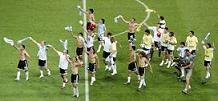Further explorations of the 22 (4-3-3)
Return To Part.1
4-3-3 is one of the most confusing formations, partially due to its resemblance to the result of a catching-up substitution to a 4-4-2. When teams playing 4-4-2 were losing, coaches often bring in an offensive player to take over from a midfielder.
In fact, the common 4-3-3 is an evolution of 4-2-4. In a 4-2-4, 4 defenders are lined up closely to provide good coverage left to right; The 2 midfielders are actually half backs to screen for the defenders and support them vertically; This 4-2 setup making it very defensive (like 3-4 in NFL). At the same time, there are alot of space in the midfield so both midfielders need to know how to initiate attacks, or the ball will never get to the 4 forwards up top. Some of the forwards also need to back track in order to have better connection with the midfield. Compared to 4-2-4, the common 4-3-3 pulls back 1 forward so the midfield could be stagged and have better connections with the front. When playing 4-3-3, the midfielders would usually stay in formation and move across the field like a screen, so 4-3-3 is actually also a defensive formation like 4-2-4 where attacking routines are usually initiated in the midfield.
However (here comes the tricky part), the 4-3-3 formation deployed by Argentina is actually an evolution of 2-3-5! In 2-3-5, the 3 midfielders are also half backs so the formation can mark 5 attackers at the same time. 2 backs mark the 2nd attacker to each wing, other 3 attackers marked by the 3 midfielders. The center midfielder in 2-3-5 could be viewed as a CM and is of great importance because he would need to mark the center attacker at the same time organizing offensives. In Argentine 4-3-3, the 2 side midfielders of 2-3-5 were set into the defensive line, then 2 attackers were pulled back to become midfielders. So in our 4-3-3, the center midfielder had the same job as the CM in 2-3-5, while other 2 midfielders were capable of offensive duties. Outside forwards in Argentine 4-3-3 usually stayed very high up so it remain a 5-5 balanced formation, like 2-3-5.
In this 4-3-3, the center attacker should stay higher than the other 2. With 5 offensive players, it would only make sense if at least 1 of them constantly hangs in the box. This is the primary difference between 4-3-3 and 4-4-2 diamond.
So, the 4-3-3 played by Albicelestes is a balanced formation that uses 2 outside midfielders to assist the CM in ball transportation. The CM is also a CDM and must mark center attacker of opposite team.
We have 4 midfielders that are capable of CDM position. Lucho's recent performance probably hurt his chance at such important role. Mascherano is the best defensively but not as good as Gago or Cambiasso in offensive organization and ball distribution so only Cambiasso and Gago are suitable for this position. Between these 2, Gago's defensive techniques seemed more refined than Cucho, but Cambiasso is probably little more experienced and has a better understanding of offensive composures. The defensive responsibilities of the CM in 4-3-3 should overweight his offensive duties because there are 5 other offensive players. Condition being he must be able to make correct choices of targets to pass to. From this point of view, Gago beats Cambiasso to the position.
Now the 2 outside midfielders. The 2 outside forwards should be allowed to channel and displace freely. So, the 2 outside midfielders must be able to play anywhere from center midfield to opponent corners. The CM also needs their assistance to disrupt opponent possessions. Cambiasso and Lucho should be our 2 defensive choices; While Veron and Riquelme being the more offensive 2. Since Gago will need help defensively (as demonstrated in friendly vs. Switzerland), at least one of the outside midfielders needs to help him. The other guy though, will likely be a playmaker from the side, so we don't risk being cutoff at midfield. I think Lucho in form would be the ideal defensive outside midfielder, that's probably why Basile chose to test him again in the friendly against Algeria despite his poor performance vs. Switzerland. To me, he performed quite well in the 2nd match. If Argentina ended up playing 4-3-3 and Lucho had earned Basile's trust, then I think we can expect to see Luis González on the right.
Then the other outside midfielder will likely be a left playmaker. Veron, Aimar and Roman are the 3 that have experiences in the job. Aimar steers better from center, and Veron is usually more defensive than Roman. On top of that, Riquelme is well experienced with the left playmaking role while Veron had played more towards the center for the later part of his career. I hate Veron, but honestly that's not the reason I would pick Riquelme over him for this spot. Riquelme is simply a better left playmaker.
First pair: Riquelme-Lucho; Second pair: Cambiasso-Veron.
With a left-hammer-right-anvil approach to the 4-3-3 midfield, attack line of the same format should also be expected. Or in other words, if vise versa, Veron and Cambiasso started, then a left-anvil-right-hammer forward lineup should be employed accordingly. Again, the center forward needs to stay high and be the target man. Tevez-Crespo-Messi should be first choice for either orientation.
que haya una ilusión después de Diego ...
One of the interesting aspects of 4-3-3 is that in the case Argentina pulling out this formation, Messi would likely be starting at the same position he had played all year long with his club team, Barça. In the 17 league games Messi played after coming back from his injury, he totalled 14 goals; scored his hatrick against Real Madrid with a 10 men Barça to equalize the game; duplicated Maradona's goal of the century (in fact there are quite a bit of differences between the 2 goals, perhaps some discussion around this subject should be brought up in the future); and steered the team without Ronaldinho to a 2-2 draw against city rival Espanyol (scoring both goals only to be equalized by opponents in the 90th minute) - all from the right front position of this 4-3-3 formation. How well he understands the position isn't even a legitimate question, and it's definitely an asset if we play 4-3-3 somewhere during the Copa. The question is, whether the advantage gained from playing Messi at his usual position can offset the generic shortcomings of 4-3-3 formation.
Fans of messi often talk about his similarity to Diego, especially now with the goal against Gatefe and the Mano de Dios 2007. I agree that some the things can't be ignored, but deep down, I still believe messi's style resembles a different classical footballer who played mostly in this 4-3-3 formation modified from a 2-3-5, and that is no other than
the most famous exponent of the football philosophy known as 'TotalFootball', the legendary flying dutchman and three time golden ball winner, Johan Cruijff.
I also believe it was no coincident that Messi plays for Barça which had been under so much Cruijff influences. On top of that, he plays in the 4-3-3 formation made famous by Cruijff's 70' Holland national team.
Regardless of the differences and similarities, there's no doubt Messi will get better and better, and there will be more incinerating displays of football at its highest level from our boy.
*A note to those yelling "Messi is a hype" or "He's a cheat that uses hands", I would like to say: "You are watching football from a totally different dimension than the one we live in. That's why you can't overlook the little imperfections and enjoy living in the same age with these colossals." The bottom line is, one can't argue that the performances from players such as Messi and Cruijff make our hearts pump and blood boil, and this is why we love the beautiful game so damn much!
back to the topic.
when the 2 offensive midfielders of 4-3-3 push upfield, the CDM and the entire backline also need to push up, so the spaces between the lines remain ideal. This also means the formation would be more susceptible to counter attacks, and consequently threatened by enemy breakaways, fouls, cards and set plays.
However, even with Frank Rajkaard's resurrected 4-3-3 Barça failing over and over at stopping counter attacks, we should not allow ourselves to show leniency towards negative football! As a reminder, please repeat the following three times: Negative -- Football -- Is -- Baaaad.
Counter attack is not just killing 4-3-3. Many other modern four back formations also require the entire backline to push up in order to allow more offensive plays, and therefore suffering similar fate.
But with only 1 defensive midfielder, and not a pure one, 4-3-3 definitely has the disadvantage in this area, similar to 4-3-2-1, which was used in the recent match against Algeria.
Argentina scored 3 goals only to conceive 2 from successful counter attacks and got a 3-2 out of the friendly. In that game a variation of 4-3-1-2 was used and we had 60% possession with 80% of the game played in opponent's half!
Offensively, that game was quite successful and we didn't get more goals only because some the chances weren't taken properly. But defensively it was quite a disaster. The friendly exposed some serious problems with the NT backline. We can only wish that coco's selection and this short period of training were enough to fix these problems in time. having them exposed in the friendlies though was absolutely a good thing as these sync errors would of hurt us hell lot more in real matches.
4-3-1-2 is actually more defensive than 4-3-3 as the CM in that formation will be more of an CDM than the guy in 4-3-3. But 4-3-3 is more offensive and offers more attacking options, so it's hard to say whether 4-3-3 would of done better or worse in the recent friendlies.
We should also avoid measuring our defensive capabilities purely by the performance from those two friendlies. The team needed time to sync, reform and become more organized. In international competitions, the teams that showed remarkable condition early on usually couldn't go far because their synchronization were forged by long term practice as a unit. To gain such experience, the players need to be mostly or all of domestic origins. In many cases, these players were avaliable for training but not necessarily the most technically gifted, and often lose eventually to teams made up with very talented players who weren't very familiar with each other at the beinging of the tournament but managed to find their form and sync'ed up during course of the competitions.
GoTo:
4-2-3-1
4-3-1-2
To Conclusion





No comments:
Post a Comment